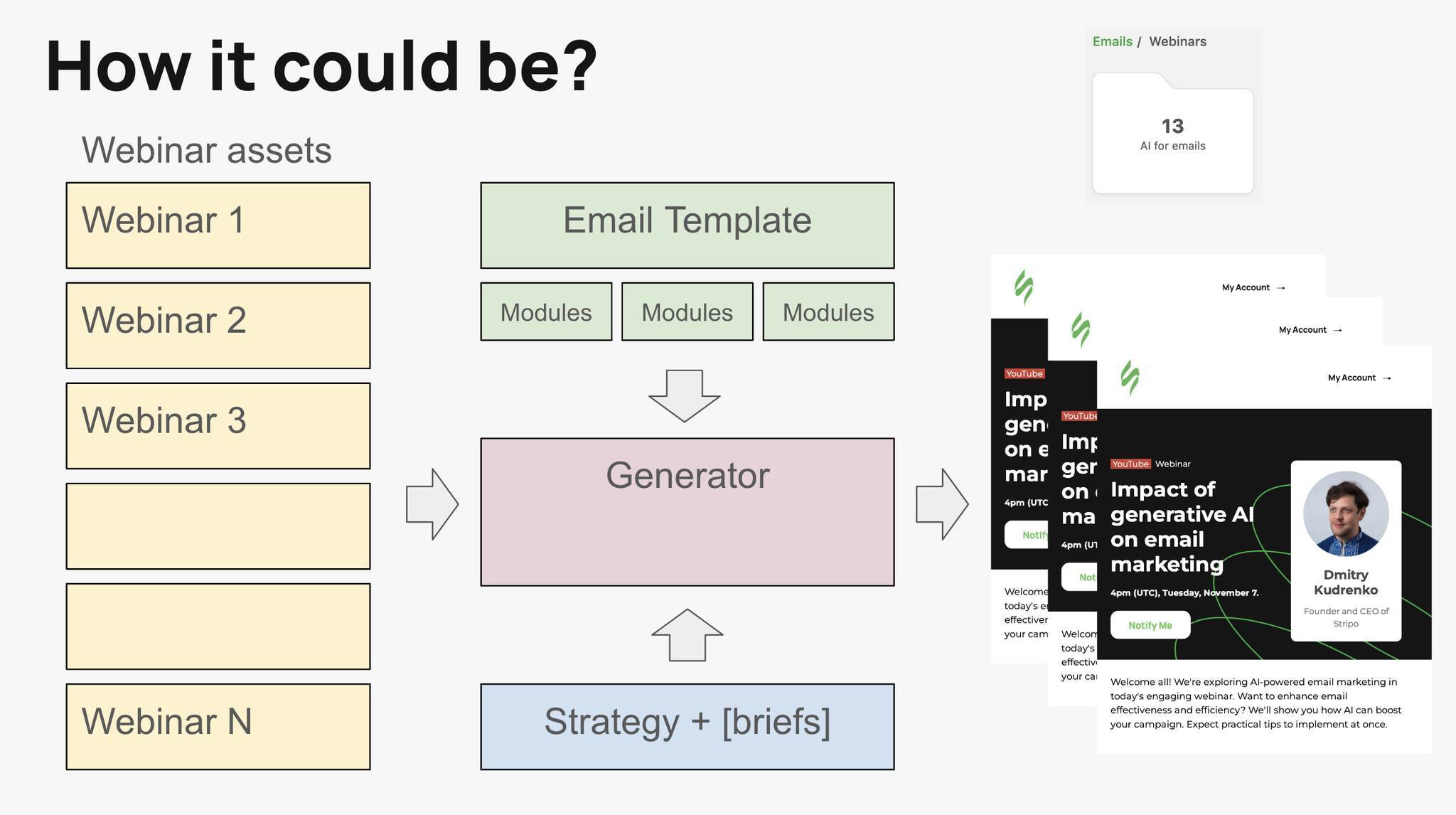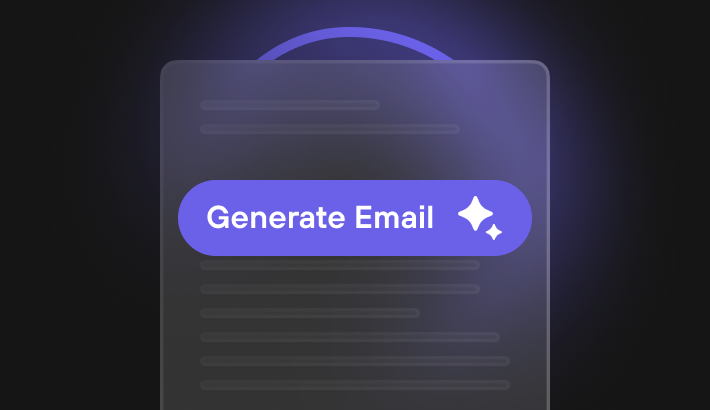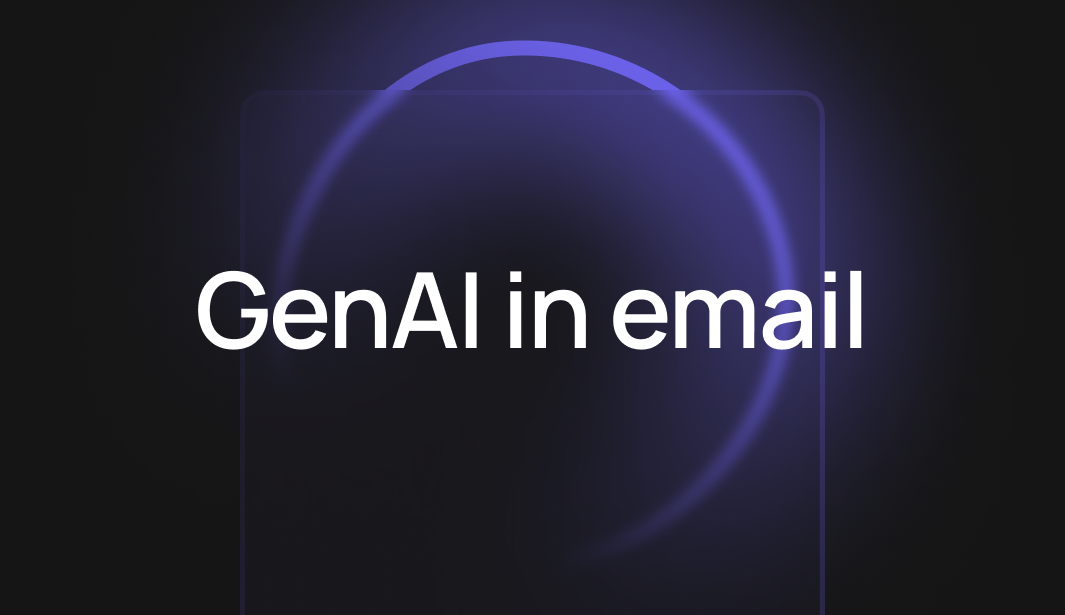Exploring the potential of generative AI in crafting marketing emails presents a fascinating frontier for marketers and technologists alike.
So, is it possible to create a marketing email with generative AI? Spoiler alert: I believe it is, and I see it opening many doors in the marketing maze. Besides my belief, we are conducting some research, the results of which I see daily and want to share with you not only the final product but also the process. Maybe you would like to share your ideas, find the desire to implement something for yourself, and follow our path in other industries.
What do we want to achieve?
For instance, you have a business task that sounds like this — "I want to support the promotion of my webinar [here's the landing page] via email." And you want to use generative AI to get an email sequence ready for launch. The emails should be made so well that it's easier to modify them than to redo them — this is the minimum success criterion, which then needs to be improved. Ideally, nothing should be changed.
This task is only one of the necessary steps that will help email marketers automate the email sequence creation process by using GenAI and focus on high-level strategy management instead of the routine of creating newsletters.
Here are the main challenges that lie ahead:
- Why hasn't the problem been solved yet?
- What is the solution plan and its components?
- What is the scope of related tasks?
- Where to start?
- Who should solve this problem (developers, marketers, or product specialists)?
- How do you prepare a sandbox for experiments?
- Why did I decide to share this not post-factum but in the process?
1. Why hasn't the problem been solved yet?
We know that GenAI is rapidly evolving in tasks like writing text, generating images, planning email strategies, parsing HTML, and even writing HTML code. However, if marketers are more or less used to trusting GenAI with texts, they are not ready to do the same with emails involving code writing. This is challenging to control due to the lack of standards and the limitations of HTML for email, which forces marketers to solve problems with methods that were not designed for this purpose.
For example, implementing interactivity using styled form elements, such as checkboxes, radio groups, etc. And constantly testing something that should work and can break at any moment is too costly. Also, brand identity and style are not something that can be entrusted to GenAI. This limitation has become a stop factor for many, with the reasoning: let's wait until email clients evolve or GenAI makes a leap in quality.
2. What is the solution plan and its components?
However, there is a solution: to leave control over the code and brand book to the marketer and delegate the rest to GenAI.
What can be considered a task done well enough? This means that if any email can be created as a sequence of predefined parameterized modules placed in a prepared template, then the task of GenAI is to determine the sequence of modules in the template and describe the parameter values of these modules.
A module is a prepared HTML code with parameters that can be changed without compromising its appearance.
The conditions are:
- email template: colors, fonts, margins, header, and footer;
- modules: banners, product cards, blog posts, social networks, etc.
Expected outcome: At the output, we get a fully prepared email sequence that we can modify or regenerate.
Solution stages:
- formation of necessary data and their structuring (assets);
- strategy formation (workflow);
- formation of an email brief according to the strategy;
- building correspondence of existing modules to elements of the email brief;
- parameterization of selected modules based on existing data;
- generation and deployment of created emails.

Questions that raise concerns:
- can there exist a finite set of modules that are easy to maintain and sufficient for implementing any email?
- what meta-description and storage of strategy, briefs, modules, and their parameters most effectively allows them to be combined with each other?
- can the creatives (images, animations, interactivity) be delegated, and in what form should the conditions of their creation be stored?
3. What is the scope of related tasks?
There is a whole set of tasks that will be automatically addressed along the way:
- generating an email in the company's design based on the image of any other email;
- adapting any HTML into an email that can be fully edited in a block editor;
- generating accompanying creatives for other sales channels;
- creating a library of ready-to-use templates, and so on.
It opens the doors to strategic tasks:
- rapid implementation of turnkey solutions in automation systems (I will use Yespo);
- automation not only of triggers but also of marketing email campaigns;
- mass implementation of changes in all triggers and promo campaigns;
- controlled automatic improvement and testing of existing campaigns;
- and more tasks that eliminate all sorts of marketers' routines.
4. Where to start?
When solving a general task, it's always easier to think through a specific case. If we were to divide emails by the complexity of their creation, I would envision a scale where on the "simple" side lie service transactional emails with a small percentage of creativity and various links, such as password resets, delivery status updates, etc. On the “complex” side lie monthly promo emails that are diverse, creative-intensive, and data-rich.
For the Proof of Concept, I believe it's essential to choose something in the middle ground, ensuring both variability and predictability in creativity, and frequent creation.
Support emails for webinar hosting seem to fit these requirements perfectly, given their:
- frequency (approximately once a week);
- multiple emails (invitation, reminder, post-event support);
- a lot of routine work leading to constant errors;
- the same data requiring constant rewriting (event date, speaker info, urgency levels, etc.), where GenAI proves particularly useful.
So, let's focus on webinar emails while constantly keeping the general task in mind.
5. Who should solve this problem?
This was the first question that sparked debate within the team. On the one hand, it appears to be a developer's task, preferably one well-versed in GenAI principles, LLM, embedding, training neural networks, understanding the differences in models, etc. They also have to understand the context of OpenAI, including concepts like functions, assistants, and more.
On the other hand, it seems to be a task for a marketer who clearly understands business needs. From a third perspective, it's research work for a product analyst who needs to formulate processes and then design the UX for users. Determining what data needs to be collected and by whom to begin active development is essential.
It seems to me that someone closer to marketing, with a clear understanding and vision for the product, should start and prepare the foundation. Therefore, even before involving a marketer, we began to explore the task from all angles simply by experimenting with prompts in ChatGPT.
6. How do you prepare a sandbox for experiments?
We started with ChatGPT, but it's quite limited in capabilities, unable to access Stripo or Yespo for real-time data, poorly controlled, and slow. So, we developed a GPT with instructions and functions that allowed connecting various services and shared this GPT with the team. However, it was also very slow; waiting for each response took time, there were request limits, and working in such a mode quickly demotivated the team.
Thus, it's better to create requests in the Playground and pay for these requests. However, it turns out that it's not possible to connect calls to external methods there, so we tried using services like PromptKnit, but it doesn't allow scaling the experiments. And it's still slow.
Therefore, we created a single space and wrote simple scripts in Replit, which automate a lot of routine work and combine many services together. It turned out to be simple, even without experience in Python programming.
In short, to facilitate research work on a complex and not fully defined task, you need to:
- create a space for collaborative work;
- automate repetitive tasks;
- provide the ability to give a sequence of commands so that they can be executed in the background;
- ensure each experiment can be repeated and saved by different team members;
- allow "non-technical" specialists to work on the task.
7. Why did I decide to share this not post-factum but in the process?
Our mission at Stripo is to improve everyone's email interaction experience, including marketers, mail services, recipients, automation systems, etc.
Those who know me also know that our team is as open as possible and has never had secrets about what we are working on, our ideas, developments, plans, and what we want to do but haven’t had the time to accomplish.
I am convinced that competitors already have their plans, which they are also struggling to implement. The sooner you articulate your idea, the sooner you receive feedback. If anyone has something to share, criticize, provide a useful link, point out a mistake, or join us to work on a case together, please do so in the comments.
Your thoughts, feedback, and contributions are not just welcome — they're essential.
Your thoughts, feedback, and contributions are not just welcome — they're essential. Let's embark on this journey together, pushing the boundaries of what's possible in email marketing.








0 comments